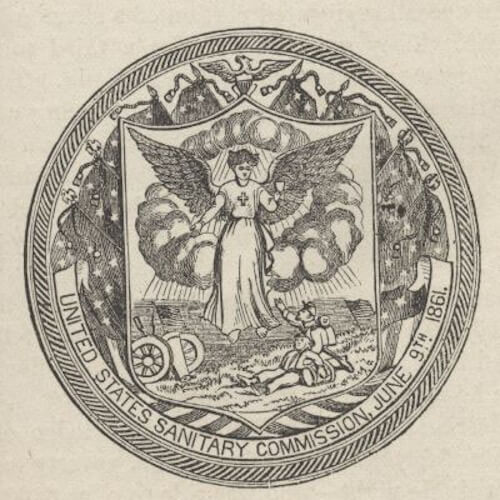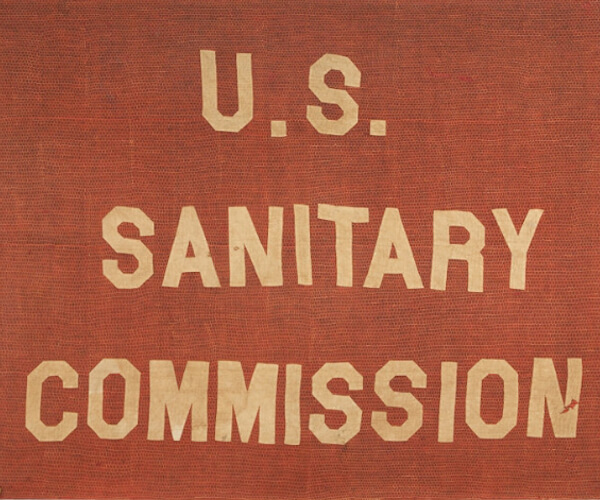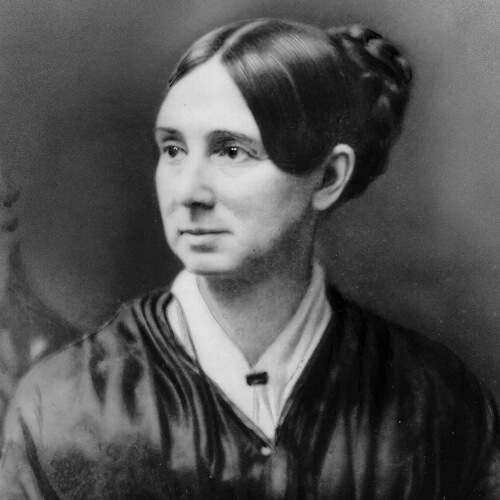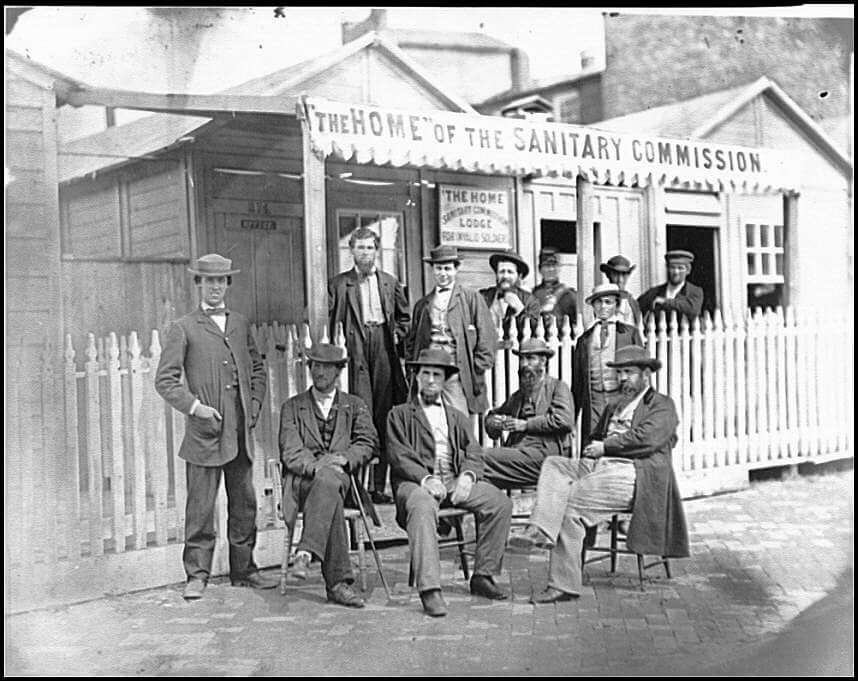Civil War Medicine
Exploring the medical practices and personnel during the Civil WarUnited States Sanitary Commission
The United States Sanitary Commission (USSC) was founded in June 1861 as the Civil War began. The purpose of this relief agency was to promote clean and healthy conditions in the Union Army camps. Thousands of volunteers joined the Sanitary Commission and staffed hospitals, raised money, provided supplies, and helped ensure soldiers understood the importance of cleanliness and sanitation.
The Beginnings
In the early part of 1861, a small group of northern men and women, met in New York City to discuss the formation of a sanitary commission. These individuals included Unitarian minister Henry Whitney Bellows and women’s rights advocate Dorothea Dix. The new sanitary commission would be modeled after the British Sanitary Commission that was established during the Crimean War. Their purpose was to provide comfort and relief to wounded and sick soldiers in the Union Army.
During that meeting, there was a great deal of discussion related to best delivering aid and comfort to the soldiers. They quickly learned that the current system of providing for the soldiers was woefully inadequate. They also realized that providing quality relief at such a large scale would be a massive undertaking. In the end, the members had developed the framework for a working sanitary commission that would be called the Women’s Central Association of Relief for Sick and Wounded in the Army.
Government Approval
It was evident to the members of WCAR that the federal government was not prepared to meet the sanitation needs of thousands of soldiers in camps across the north. Bellows saw that there was a need to redesign the existing sanitary and relief system. He, along with other members of WCAR, met with doctors, military personnel, and other agencies to determine the best way to meet this challenge.
In the aftermath of the battle of Bull Run, WCAR volunteers realized the massive need for medical supplies, proper sanitation, food, and other comfort items. In an effort to gain support for his organization, Bellows met with Simon Cameron who was the Secretary of War. Rather than helping WCAR, Cameron suggested forming an organization that was based in Washington, DC that could provide support and assistance to the Union Army. This new organization would become the U.S. Sanitary Commission and was approved by President Abraham Lincoln on June 13, 1861.
The Role of Women
While Bellows may have been the leader of the organization, it was the women volunteers who made the US Sanitary Commission run like a well-oiled machine. Thousands of women rushed to lend a hand. It is estimated that these volunteers raised an estimated $25 million in cash and donations. That is over $40 million in today’s money. In addition to collecting donations, these volunteers helped make bandages for wounded soldiers, made uniforms and other articles of clothing, they worked as nurses and other important tasks. They also organized Sanitary Fairs in various cities all to support the Federal army with supplies while raising money for the USSC
It is estimated that over 15,000 women volunteered for the USSC, many in hospitals. Under the direction of Dorothea Dix, many women helped by caring for the wounded, helping surgeons, dispensing medicines, cleaning wounds, and changing dressings. Many even helped soldiers write letters to loved ones back home or comforted them as they lay dying in a hospital far from home. The middle-class women who volunteered provided vitally needed nursing services and were rewarded with a sense of patriotism and civic duty in addition to the opportunity to demonstrate their skills and gain new ones, while receiving wages and sharing the hardships of the men (Leonard, 1995)
Continuing the Good Work
As the war continued, so too did the work of the Sanitary Commission. As the number of wounded grew with each passing battle, the USCC rose to the challenge. In 1862, the first hospital ships were launched and held upwards of 1,000 wounded soldiers. Their purpose was to quickly relocate wounded soldiers to safe locations in the North. These new, floating hospitals were completely outfitted and staffed by volunteers of the Sanitary Commission. There were times throughout the war that the Sanitary Commission was able to upstage the Army’s Medical Department by providing better care and more resources than what the army could provide. And the war dragged on and the Sanitary Commission kept pace. They were at every major battle including Chancellorsville, Gettysburg, Petersburg, and Atlanta.
When the Civil War finally ended in 1865, the work of the USSC continued to care for the wounded in hospitals throughout the North. Through their work, they also played a role in negotiating the return of prisoners, helped soldiers get pension monies and back pay, and helped soldiers return to normal life back home. It was not until October 1865 that the work of the Commission officially ended.
Additional Information
The USSC at Gettysburg
Following the Battle of Gettysburg on July 1-3, 1863, the Sanitary Commission was quickly on hand to help the over 30,000 Union and Confederate wounded. Commission volunteers arrived with wagons full of much-needed supplies. Their work did not go unnoticed and according to Union General Herman Haupt, “as these wagons, bearing the familiar inscription “U. S. San. Com.,” came in sight, a Surgeon who was standing at a point not five hundred yards in the rear of the line battle, surrounded by sufferers for whose succor he had exhausted all the means at hand, exclaimed with joyful eagerness, “Thank God, here comes the Sanitary Commission; now we shall be able to do something.” (Still, 1887).
As the days and weeks following the battle wore on, the volunteers continued to help in the various makeshift hospitals around the battlefiled and then in Camp Letterman. The surgeons who worked on the wounded wrote of the enormous help the Sanitary Commission provided following the battle. One surgeon wrote, “at the manner in which the affairs of the United States Sanitary Commission have been managed since the late battle. The supplementary articles for the sick and wounded have been abundant, comprising every requisite which the exigency demanded, and which nothing but a well-regulated system, with much experience and forethought, could have secured.” (USSC, 1863)
Dr. Elizabeth Blackwell
In addition to being the first woman in the United States to earn a medical degree, Dr. Elizabeth Blackwell was one of the early and more influential members of the WCAR. On April 26, Blackwell and Louisa Lee Schuyler organized a meeting of 4,000 women at Cooper Union in New York which would become the Women’s Central Association of Relief for the Sick and Wounded of the Army. Blackwell’s knowledge of medicine was critically important for training new nurses who would eventually travel to army camps to tend the sick and wounded.
Growing Pains
The USSC was not without its problems. In order to accommodate the rapid growth and massive organizational needs of the Commission, the leaders quickly realized they needed to reorganize. At its high point, the USSC was in over 2,500 communities and they were supported by thoughts of local women’s aid societies that sent articles of clothing, uniforms, hospital supplies, and much more. All of which had to be sorted, organized, repacked, and shipped to where it was most needed. In an effort to divide up the work and better support local efforts, the USSC created twelve branches that would be run entirely by women with the sole purpose of supporting major cities including New York, Boston, Philadelphia, Pittsburgh, Cleveland, and Detroit.
Sanitary Fairs
Sanitary fairs were civilian-organized bazaars and expositions dedicated to raising funds on behalf of the United States Sanitary Commission (USSC) and other charitable relief organizations. Over the course of the Civil War, they became one of the most popular means of fundraising for the Union cause. The first Sanitary Fair was held in Chicago, Illinois, in 1863. Called the Northwestern Soldier’s Fair, this two-week event raised about $80,000 to benefit the U.S. Sanitary Commission. The fair was organized by women. The crafts, food, and entertainment for sale at the fair were mostly created and provided by women. All the money earned was used to support the care of wounded and sick soldiers.
Learn More
Videos
Vocabulary
Association – a group of people organized for a joint purpose.
Commission – a group of people officially charged with a particular function.
Donation – something that is given to a charity, especially a sum of money.
Hygiene – conditions or practices conducive to maintaining health and preventing disease, especially through cleanliness.
Organization – an organized body of people with a particular purpose, especially a business, society, association, etc.
Sanitation – Conditions relating to public health, especially the provision of clean drinking water and adequate sewage disposal.
Volunteer – a person who freely offers to take part in an enterprise or undertake a task.
Welfare – the health, happiness, and fortunes of a person or group.




